| THE PALAZZO DEI TRECENTO IN TREVISO, Old centre |
| |
| The Palazzo dei Trecento was raised about 1185 in Treviso to have
a meeting room where several representatives could assemble; the construction of this building
ended in 1268 when the next edifice assigned to jail was ended. |
| |
|
In the history of the town the palace was the seat
of the Tribunale dei Consoli (Consuls’ Court), place of public meetings (the "Concione"),
place where the Podestà administered justice and seat of the Council; the name "Palazzo
della Ragione" came from this, before new Domus Comunis (which replaced that building
located near the Duomo - Cathedral). In the history the Palace was the seat of Municipal
Supreme Assembly too (the Maggior Consiglio), which was formed by three hundred members;
its definitive name "Palazzo dei Trecento" comes just from this use. |
 |
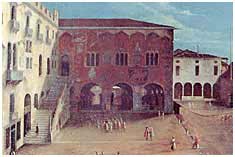
The Palazzo dei Trecento Medoro Coghetto (1707-1793) Treviso, Museo Civico L. Bailo |
| |
|
| |
|
| The original arcade covered the whole perimeter and it contained
before the most important Municipal Offices and after the shops; this arcade had been prepared to quarter a
squad of fifty knights at the service of a captain. |
| |
|
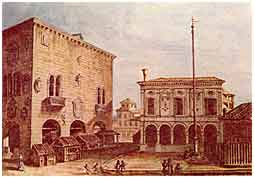
The Palazzo dei Trecento
by Antonio Sala - 1889
Treviso, Museo Civico L. Bailo |
 |
The arches, appearing at the squares, were
opened wholly after the restorations in 1552; these works allowed the touch between two squares and the
loggia of Palazzo dei Trecento was made.
This Palace appears us as a majestic four-sided building made
by rough bricks; upper zone is decorated by a battlement as a fortification.
The Palazzo dei Trecento was restored between the end of 19th century and today: the staircase was moved from
the West side to the East side, the battlement was rebuilt and it became Guelph and the extensive damages,
due to airstrikes of 1944, were repaired. |
|
| |
| |
|
The restorations, ended at the beginning of 20th century,
involved the Palace, the Prefettura (the Prefecture) and the Municipal Tower, which were decorated by a Ghibelline
battlement. At the end of 1940s the swallow-tailed merlons were removed by the repairs of Palazzo dei Trecento,
damaged in the Second World War, and they were replaced by flat-topped merlons.
The entry staircase to the first floor hall is one of architectonic outside elements, which sustained the most
important changes in the history of this building. There were two staircases set against the fašade facing to
Piazza delle Donne (today called "Piazza Indipendenza") and one overlooking Piazza dei Signori in the beginning. |
|
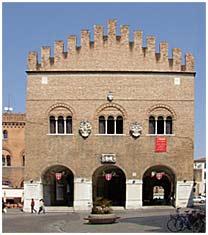
The main facade of the building |
| |
| |
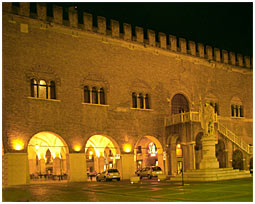 |
|
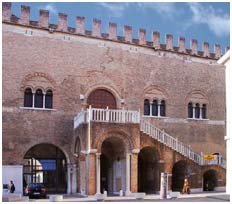 |
| |
|
In 1810 the two staircases facing to Piazza Indipendenza (see the two photos above) were
demolished it is possible to see this fact from some documents next to 1800.
The staircase on Piazza dei
Signori side was demolished after the second half of 19th century in expectation of rebuilding in the original
position in Piazza Indipendenza. Thus the staircase with one flight was raised on this side of the Palace and
only after the demolition of the shops risen in the lee of that same fašade. |
| |
| [ photos and information about hall frescoes ... ] |
| |
| |
| |
|
| |


